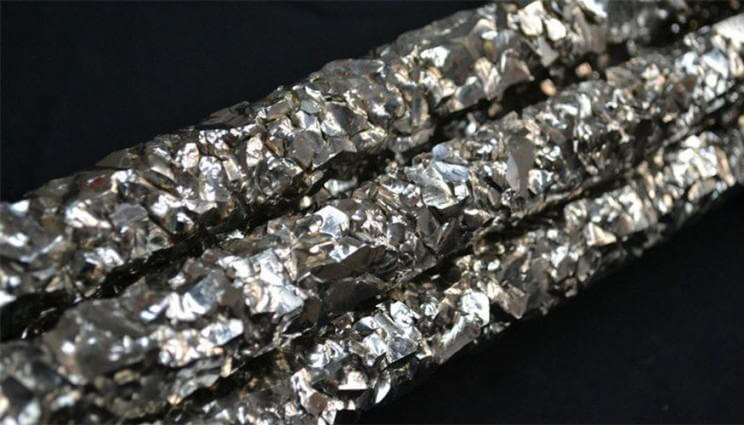What is Zirconium? Explore the intriguing world of zirconium, a metallic element with numerous uses. Discover its discovery, properties, production methods, applications in nuclear energy, alloys, gem industry, and various compounds like zirconia and zirconyl chloride.

Zirconium; (symbol Zr), a metallic chemical element with atomic number 40. Zirconium was discovered by Martin Heinrich Klaproth in 1789 while he was studying some semiprecious stones from Ceylon. It is in Group IVb in the periodic classification of the elements, along with hafnium and titanium. It has an atomic weight of 91.22, being made up of five stable isotopes of atomic mass numbers 90, 91, 92, 94, and 96, and three that are unstable, namely, 93, 95, and 97.
The known deposits of zirconium are greater than the sum of all copper, nickel, lead, tin, zinc, and mercury deposits and constitute 0.028 percent of the earth’s crust. In the United States deposits occur in Florida, California, Oregon, and Idaho, and large reserves are found in Australia, Brazil, and India.
Zircon, ZrSiO4 (zirconium silicate), and bad-deleyite (almost pure zirconium dioxide) are the commercial source minerals of the metal and its compounds. Zircon and baddeleyite may be decomposed into more chemically active compounds either by fusion with NaHSO4 (sodium bisulfate) or Na2S2O7 (sodium pyrosulfate) or by the action of strong reducing agents, such as carbon, in an arc furnace.
Production
Metallic zirconium can be produced by the Kroll process, which involves the purification of zirconium tetrachloride by sublimation and the reduction of the tetrachloride vapor by molten magnesium. The van Arkel process gives a purer metal but is more costly and is not suitable for quantity production. It involves the dissociation of zirconium tetraiodide and the deposition of zirconium on a metal filament at about 1300° C. The deposited zirconium has high ductility but low tensile strength.
Unless special separation methods are used in these processes, the zirconium produced contains from 0.5 to 3 percent hafnium, the reason being that zirconium and hafnium have very similar properties and always occur together in nature. Zirconium can be separated from hafnium by fractional distillation, fractional crystallization, column chromatography, and solvent extraction. The distillation method involves the preparation of the addition compounds 3ZrCl4 2POCl3 and 3HfC4 2POCl3, followed by distillation in which the hafnium compound boils at a temperature 5° lower than does the zirconium compound. The principle of solvent extraction involves the chelation of both zirconium and hafnium with thenoyltrifluoroacetone, resulting in compounds that are soluble in organic solvents and can therefore be preferentially extracted.
Uses
Because zirconium has a very low tendency to absorb slow neutrons and a remarkable resistance to corrosion over the wide range of conditions that can occur in reactor service, it is extremely useful in the field of nuclear energy. Other uses include surgical instruments, pins, screws for bone repairs, spinnerets for the spinning of rayon fibers, alloys, and powder metallurgy. The metal in powdered form is used as an ammunition primer, in smokeless flash powders, in blasting caps, and as a “getter” in vacuum-tube manufacture.
Compounds and Their Uses
Zircon, the chief ore of zirconium, is extremely inert chemically and is stable up to about 1500° C, above which it dissociates into zirconia, Zr02, and silica, SiO2. Gem zircon has a hardness of 7-7.5 and the highest specific gravity (4-4.8) of any commercial gem. When zircon is heated with soda, lime, or potash in the presence of acids, zirconates are formed. Zirconium carbide is produced by heating zircon with carbon in an arc furnace: ZrSiO4 + 4C → ZrC + SiO + 3CO. The carbide melts somewhat above 3500° C and is extremely hard and refractory. It burns in air upon removal from the arc furnace, forming reasonably pure zirconium dioxide.
Zirconium tetrachloride, tetrabromide, and tetraiodide are manufactured industrially by reacting the respective halides with zirconium carbide in the presence of carbon. The trichloride and dichloride also exist, as do the corresponding bromides and iodides. The tetrahalides are all colorless crystalline compounds that sublime at about 300° C and above and, except for the tetrafluoride, readily hydrolyze to form the oxyhalides, such as ZrOCl2 • 8H2O. Salts of the composition M2ZrF6 and M3ZrF7 fluozirconates, are formed by the reaction of fluozireonic acid with alkalies. The fluozirconate M3ZrF7 is a rare example of zirconium exhibiting a coordination number of 7. The hexafluoro ion (ZrF6)^2 is the most stable complex of Zr (IV).
Zirconium oxychloride or zirconyl chloride, ZrOCl2 • 8H2O, is a colorless crystalline substance readily soluble in water and in alcohols. It is used in pharmaceuticals, in water repellents, and in the preparation of printing-ink pigments from acid dyes by precipitating these dyes from aqueous solution to form compounds of intensely colored solids.
Zirconium dioxide, or zirconia, is the only stable oxide under ordinary conditions, although ZrO and ZrO3 are also known to exist. Zirconia is a white crystalline substance that melts at 2677° C and is extremely unreactive at room temperature. It finds use in resistors, enamel pigments, radiography, refractories, as an abrasive, and as a raw material in preparing metallic zirconium and zirconium compounds.
Hydrous zirconia, ZrO2 • xH2O, is precipitated when alkali is added to a solution of zirconium salt. A number of uses result from its remarkable adsorptive and complexing properties. Hydrous zirconia precipitates urushiol, the active irritant of poison ivy, and is therefore useful in the treatment of poison-ivy dermatitis. It is also used in deodorants.
There are many compounds in which oxygen or nitrogen form a link between zirconium and carbon. Zirconium tetracetylacetonate, the compound resulting from the chelation of acetylaetone with Zr^4+, is a typical example of zirconium exhibiting a coordination number of 8. Coordination compounds of zirconium are used as catalysts for ammonia synthesis, organic oxidations and syntheses, esterifications, cracking, polymerizations, and in the conversion of sulfur dioxide to sulfur trioxide. Disulfate zirconylic acid is the best known sulfate and is used in tanning leather and in precipitating amino acids.